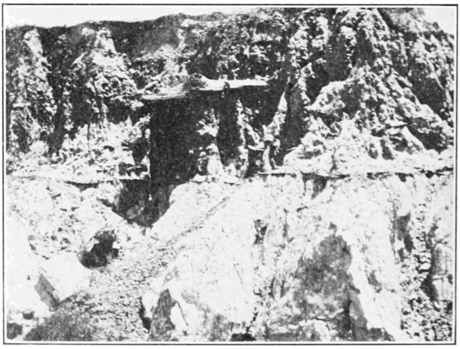Popular Science Monthly/Volume 83/November 1913/The Petrified Forest of Mississippi
| THE PETRIFIED FOREST OF MISSISSIPPI |
By Professor CALVIN S. BROWN
UNIVERSITY OF MISSISSIPPI
THE petrified forests of Arizona are well known to geologists and others interested in such things, but I am not aware that anything has yet been published on the petrified forest at Flora, Mississippi.
There are various forms of petrified woods in the state of Mississippi, but the great majority of them are silicified woods. Many of them are white or at least light-colored, and because of the color often go popularly under the name of hickory wood or hickory logs. Petrifactions which are formed in the lignite beds are often stained to a dark brown or even black shade; one and the same trunk is sometimes found partly petrified and partly lignitized. In the northeastern corner of the state there are also found samples of wood in which iron-ore is the material replacing the original woody structure. The beautiful wood jaspers, carnelians, opals and agates of Colorado, Arizona and other western states, are not ordinarily to be found in this state; though the Mississippi trees sometimes show excellent quartz crystals of small size.
Much of the Mississippi wood shows the vegetable structure almost perfectly and tends to split with the grain of the wood. Through a large
Fig. 1. Showing line of demarcation between Quaternary and Tertiary. Above this line a log is seen in its original position. Flora, Miss., June, 1912.
Fig. 2. A Petrified Log about Six Feet in Diameter and Twenty Feet Long, Split throughout its Length. Behind it is seen the erosion wall. Beneath the log evidences of erosion may also be seen.
Flora, Miss., June, 1912.
part of it is exogenous, good specimens of palm-wood are found in south Mississippi.
Most of the petrified wood in the state is found in the Lafayette formation but some is found lower down in the Wilcox and other Tertiary formations. Dr. Hilgard surmised that a great part, if not all, of the silicified wood found in the upper formation was derived ultimately from the several lignitic stages of the Tertiary.
The petrified forest, or speaking more accurately, the group of silicified logs, which I wish particularly to mention in this brief article, is found near Flora, seventeen or eighteen miles northwest of Jackson, the state capital. Here is a large field where erosion is actively taking place at the present time. Throughout the area are scattered logs and fragments in varying stages of disintegration.
An amphitheater some twenty or twenty-five feet deep and about one hundred and fifty feet in diameter, where the Columbia loam and the Lafayette sand have washed away down to the Tertiary formation, offers the best single exhibit of the logs. At the mouth of the valley the erosion has extended several feet into the Tertiary. There are at least ten logs exposed in this amphitheater which vary considerably in color and composition. Some of them arc almost pure white and apparently contain nearly pure silica; others are stained with more or less of foreign matter.
These logs vary in size and preservation and none of them presents the full length of the original tree. The largest observed is about six feet in diameter by twenty feet in length and is of a brown color.
Fig. 5. Petrified Log from Pittsboro, Miss., now on the lawn of Dr. Calvin S. Brown at the University of Mississippi.
Another is four feet at base by about seventeen feet in length. A dark colored log near by is five feet at base and eleven feet long. Another in a ravine to the east is four feet by twenty feet; and there are still other logs and fragments of logs scattered at various points.
Most of these logs now rest upon the Tertiary formation and therefore are slightly displaced; that is to say, the sand of the Lafayette formation has washed from beneath them and left them lying upon the Tertiary. In several places however in the vertical erosion walls logs are seen projecting from the Lafayette sand some distance above the Tertiary.
In the accompanying illustration, number four, the line of union between the Quaternary and the Tertiary is distinctly seen running horizontally through the middle of the picture. Some distance above this line is seen projecting from the Lafayette a log in its original position, No stumps in situ were anywhere observed by the present writer, nor were any small branches or roots found. There are many excellently preserved knots, a beautiful example of which is seen in the picture just mentioned. So far as observed by myself, there are no other fossils in this field; but further investigation is desirable.
It is evident that disintegration is going on very rapidly in this silicified wood. The difference in the appearance of several logs was clearly noticeable after an interval of fourteen months which elapsed between two visits to the Flora forest. The principal agent in disintegration seems to be freezing; rainwater penetrates the logs and by freezing splits them. A tree which has been exposed in the writer's yard but a short while (Fig. 5) shows signs of splitting, while another in the university museum is as well preserved as when Dr. Hilgard put it there over sixty years ago.
While the Mississippi forest can not be said to rival in extent or in the coloring of its petrifactions the celebrated forests of Arizona, it is nevertheless a fine illustration of an interesting phenomenon of nature.




